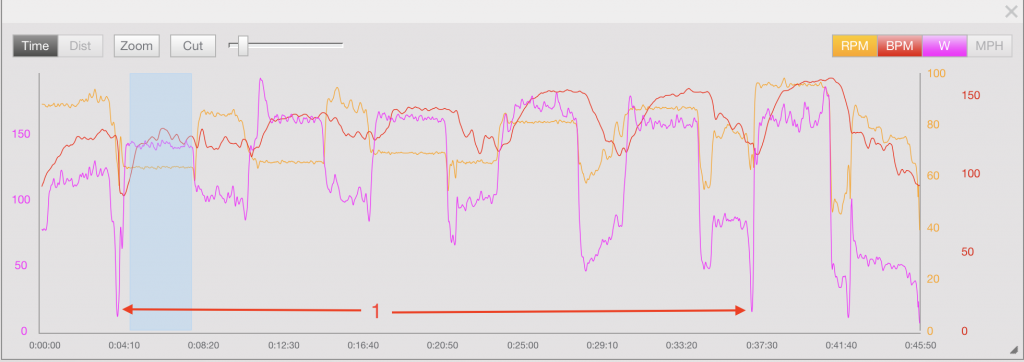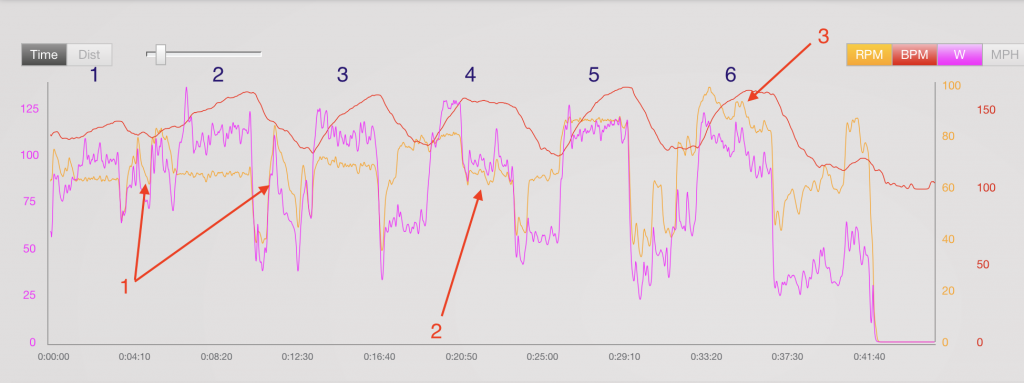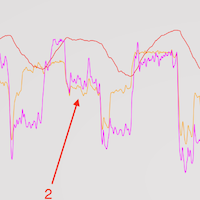Recently I asked you to look at the two files below and write in the comments what you think caused the changes in power or heart rate. Karyn Silenzi is the winner and was pretty much spot on with her analysis. Bill Pierce added a few additional points. One other person messaged me and said she wasn’t comfortable posting her response, but gave her analysis and asked some questions.
You can refer back to the original post here to read the description and Karyn’s and Bill’s full response in the comments. In the interest of keeping this shorter, I will only highlight their key points in this post.
These two files are from the same class, two different riders.
As a reminder, in the files below, the yellow is cadence (RPM), visible on the right axis. The red is heart rate (BPM), also on the right axis. The pink is power (W, for watts) on the left axis. (Tip: Use a straight edge to line up with the corresponding axis to estimate the rpm, bpm, or wattage.)
Rider #1
Bill Pierce was correct in guessing that this was me! I wanted to give you an example of what the profile should look like so you could more easily ascertain what was going on with rider #2.
Karen was correct that after a higher-cadence warm-up, these were six sets of approximately 4-minute intervals at FTP, with the first one a bit lower. (The blue shaded segment below is interval #1.) Recoveries were about 2.5 minutes.
She guessed that the cadence in the intervals was a 60, 65, 70, 80, 85, and 95. Oh man, that’s so close! Based on the bpm of my songs, they were 64, 66, 72, 81, 87, and 98. The purpose of the ride, other than a threshold workout, was to note the difference in heart rate response as cadence increased, even at the same power output. I had been teaching my riders that heart rate was the “cost” of the effort and knew that this profile would provide a very quantitative example of what that means.
Karyn suggested I was distracted in interval #4. That could very well be the case since I was teaching! To give a little clarity, this was my winter training group, and we were 6 weeks into a 10-week program. Some sessions (like FTP tests) I spent a lot of time off the bike; this wasn’t one of them.
What you can definitely notice here is the physical response is much higher at the higher cadence. To be honest, I think my power was erratic in the sixth interval because I was focusing on my riders, but it’s also much harder to keep constant at 98 rpm, even for me. Still, the average wattage was still around my FTP; the high heart rate response was mostly due to the high cadence and not so much cardiac drift as Karyn suggested. Try this on yourself to notice how your heart rate responds at progressively higher cadences at the same output.

Rider #2
My student Gloria is 65 years old. Her FTP is about 118. Yes, she struggled a bit.
These three points (the red arrows in the image below) are where she struggled and are what I wanted you to focus on. I’ve also numbered the intervals to make it easier. Gloria didn’t hit the start button on the power meter until just before the first interval, so her warm-up data isn’t available.
- These are *supposed* to be recovery!
- What happened in this interval? (hint…look at the power as the cause)
- What happened in this interval? (hint…look at the cadence as the cause)

The red arrows marked #1 were supposed to be recovery. Gloria is one of those who thinks she could be burning more calories and getting a “better” workout if she doesn’t lower her power as much as she should. I’ve been working on this with her for a while, but when I showed her this diagram, she finally understood it! You can see she was forced to go much easier after interval #3; that’s because riding at threshold is not easier. Karyn was correct when she said this rider went too hard at the beginning of interval #2 and was forced to back off.
Gloria was good at holding the cadence pretty steady for intervals #1, 2, 3, and 5. In fact, the cadence for interval #4, 81 rpm, is one that she also should have been able to hold, but as Bill suggested in his analysis, she blew herself out and went too hard (red arrow #2). Since she was breathless, she was forced to back down, and as you can see, she backed off her cadence to drop her power. She probably also dropped her resistance a bit, but when I showed her this file later on, I asked her the next time she encountered this to try to hold her cadence constant while reducing only the resistance. This turned into a great learning moment for Gloria to be able to see this quantitatively.
Interval #6 is where the higher-cadence got the better of her (red arrow #3). Both Karyn and Bill were spot on with their analysis of this interval. Gloria is actually pretty smooth up to about 90 rpm, so this was simply too high for her to maintain. Her heart rate shot up quickly, and even when she lowered her cadence, it remained high.
With this in mind, can you imagine if you had heart rate and power data for one of those classes that consistently pushed riders into cadences of 120 or even higher?
Here are a few more questions to ask yourself:
1. Knowing that rider #2 struggled a bit, how might that impact your coaching in the future?
Karyn suggested the following for Gloria: She needs to have faith that she can maintain FTP by slightly adjusting one or the other. It looks like she was just choosing the wrong combination and petering out. She was pushing too much gear too often and that tactic blew up on her. Have faith that if you can hold a certain wattage for 20 minutes you can do so if broken up into 5 interval sets with PROPER RECOVERY.
This is excellent, Karyn! I’ve coached her to be more cognizant of her recoveries when doing intervals, making sure to breathe and relax and lower her power to Zone 1 so that she has what she needs to reach the desired output for the intervals.
2. If you don’t have the ability to analyze your riders’ workouts like this, how might this knowledge help you when coaching your own riders through an interval class like this?
Does this help? I hope more of you will give it a go when I put up the next power analysis! Let me know if you have any more questions and how this might help you in the future.

